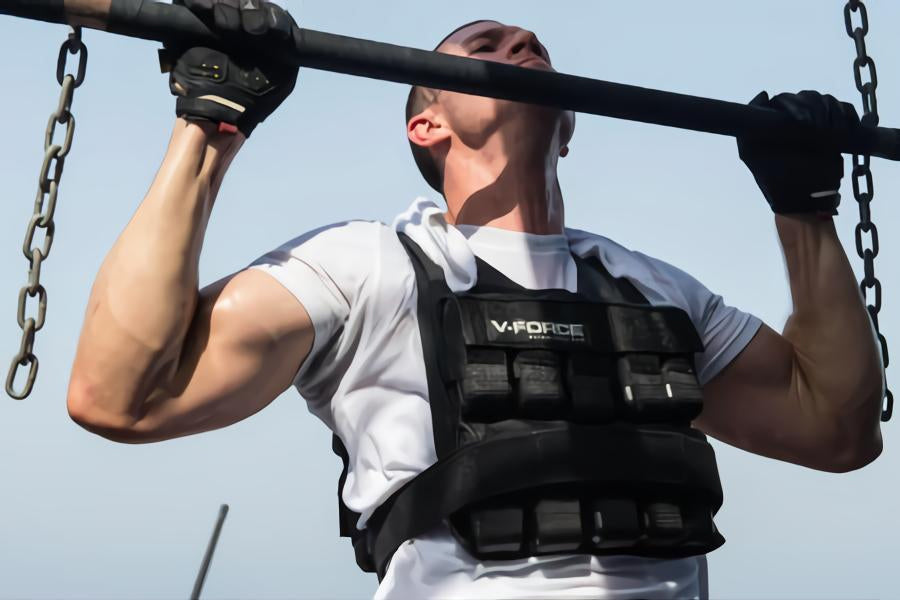Everyone dreams about training like an olympian, but no one thinks about following a US military legend! As unconventional as it is, the Murph workout is great for those looking to build massive strength and endurance with a simple and straightforward workout plan.
The Murph Workout is named after Michael P. Murphy, a Navy SEAL Lieutenant killed in action on June 28, 2005, in Afghanistan. Murphy was highly decorated and even won the Medal of Honor, the highest award available to soldiers in the United States military, making him the first person to receive it since Vietnam. After joining the military to achieve a high level of physical fitness, Murphy created his own CrossFit workout called "Body Armor."
The Murph workout consists of:
- One mile run
- Pull-Ups
- Push-Ups
- Squats
- One mile run again
The premium version of the Murph includes a weighted vest as well. We are digging deep to find out how to do it and its benefits, so hop along!
Benefits of the Murph Workout
The Murph is not just a way to honor the services of our military heroes, but it also adds to one's strength big time. There are quite a few tempting benefits, and they are listed below:
Boosts Mental Toughness
Aside from the numerous physical advantages of this endeavor, doing a Murph Workout necessitates significant mental work - concentration and perseverance. Completing this task should be regarded as a major psychological victory since you'll have to run a mile, do six hundred total pull-ups, push-ups, and squats, then add another one mile.
The workout is challenging, without a doubt, and quitting may cross your mind several times. However, at the end of that second run, you'll feel the most satisfaction you've ever felt for having won over your own desire to relax and lag.
Simplicity
One of the biggest advantages of the workout is its simplicity. No equipment, no complex moves; it is very straightforward. It's so simple that there is absolutely no excuse for anyone; it's just you and the workout, and nothing is stopping you other than your own lack of commitment.
You do not need to watch any tutorials to pull it off: the Murph exercises are basic ones that everyone knows. Just a few bucks for an insulated water bottle to stay hydrated as you sprint through this intense routine.
Related Article: Here’s How Hydration Supplements Supercharge Your Summer Workouts
Total Body Training
The workout is minimalist, but there are no compromises on efficiency. The Murph moves are compound exercises that engage major muscle groups in the body, leading to an overall, full-body strength pattern instead of targeting specific muscle groups and ignoring others.
Compound exercises like push-ups, pull-ups, and squats burn more calories in a shorter amount of time, helping you reach your fitness goals faster. They also build muscle mass faster. The best thing is that they are functional exercises that transfer well to real-world activities.
Related Article: Compound Vs Isolation Exercises
Can Do It Anywhere
You just need to have the will for the Murph and not a particular environment and place to do it. You can do it at home with a treadmill, in the park, at your workplace or in the gym. There are no restrictions at all, and this feature makes it a great choice for busy bees of the 20th century.
Supports a Good Cause
Last but not least, it honors the military legends who spent their lives serving the country and died defending it. There is a bigger purpose behind the workout, and that works as a motivational factor.
7 Steps to Completing the Murph Workout

We are giving you seven steps to help you ease through the Murph workout. The steps consist of an assessment of your strength and pace as well as a few simple strategies to successfully complete the challenge that comes with this tough routine.
1. Assess Your Strengths and Weaknesses
Before you start and feel intimidated to the point of dropping the idea of doing it, you can assess which of these exercises feel comparatively easier to you than the others. It's important to know which one brings that lump in your throat when you think about it and which one seems more doable; the move that you can do without feeling anxious.
This realization goes a long way, and it helps you decide which ones will go first and which ones need to come in late.
2. Do the Math
Next, do your math; how much pace can you sustain i.e. how fast you can go through the exercises completing the required reps. The first two steps are about knowing your own strength and limits to plan out a strategy for successful completion of the Murph every time.
Start with your weakest movement; make sure you start with smaller sets in the beginning. Next, keep testing the pace that you can sustain without giving up.
Do power reps and longer sets early on when your body has high energy. Start doing smaller, low-frequency sets when you are done with high pace, high rep sets instead of giving up altogether. This helps achieve more before reaching muscle failure and you can maximize performance and gains with this pattern.
It's common to feel overwhelmed in the initial days of the Murph workout, but going systematic really helps preserve your energy and makes you last longer than even your own expectations. You will handle the physical and mental fatigue much better.
3. Establish a Constant Pace
One great way of being constant with your Murph is to go slow and steady initially and avoid sprinting in the opening run. Save the energy to be expended slowly and equally throughout the length of the workout. This is the key to establishing a constant pace. This way, you'll last longer than wasting away in fewer, powerful reps.
If you lose most of your energy reserves in the opening run and reps, you will be exhausted soon and won't be able to maintain a constant pace through the push-ups, pull-ups and squats.
4. Avoid Hitting Your Lactate Threshold Too Fast
It's important to go slow on running because too fast can mean reaching your lactate threshold too soon, and that also means a portion of your accumulated lactate will inevitably end up in the lower body- legs to be exact, no matter what type of exercise routine you are following.
This is why you start feeling fatigued and sluggish sooner than required, which can affect your performance in the bodyweight exercises of the workout- push-ups, pull-ups, and squats. Stay steady by starting slow: it's best to expend your energy in a controlled manner.
5. Rehearse the Workout
Keep your body accustomed to the intensity and the pattern by rehearsing the workout. This way, it's easy to handle the intensity of the workout as your body gets used to it and does not feel fatigued too soon into a session.
Although doing different exercises and surprising the body with new patterns have their own benefits, demanding and exhausting routines like the Murph requires practice and familiarity, so your body feels confident. If you feel it's too difficult, your body will follow in your footsteps, adversely affecting your workout performance.
6. Don't Run on an Empty Tank
Well, it's too tough to be done on an empty stomach. Never exhaust yourself by going extra strict, trying something as daunting as the Murph on an empty stomach. You need all the energy you can muster to pull through this routine, which needs a full tank.
At the same time, it will be a grievous mistake to run on a full tank, too. Keep yourself energized but not full when you start this workout. Having a full stomach makes you sluggish, and you do not want that on the Murph. You need all the energy and endurance to get through the workout successfully, so act smart.
7. The Last Mile
The last mile is different from the initial one; You won't have the same energy as you did in the first mile. You'd be exhausted from exercise. Naturally, you'd want to slow down a bit to let your energy reserves replenish. So, go slow for the first half-mile.
It's natural to feel tired after hundreds of push-ups and pull-ups; taking the first half-mile slow will allow the body to gather courage for sprinting. Go supersonic in the next half, maximizing the perks of the workout. This movement pattern helps balance fatigue and muscle soreness, and you are not left miserable at the end of it.
Conclusion
The Murph (a workout plan named after a military legend and performed as a tribute to him in honor of his services) is a challenging workout for most because of the intensity and frequency of the exercise involved. It may be simple with basic exercises onboard, but it's challenging nonetheless. The article discusses the benefits of the workout and strategies to manage the Murph successfully. It becomes a lot easier to manage the fatigue and stand the intensity of the workout with the strategies mentioned above.











